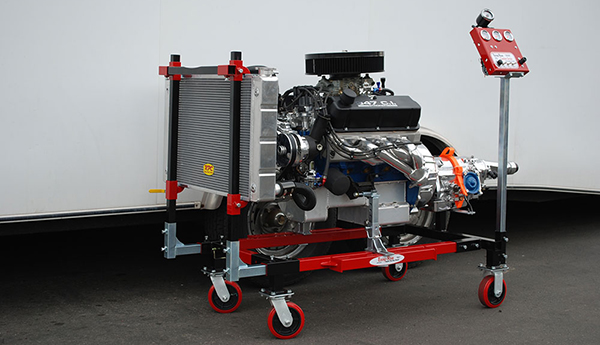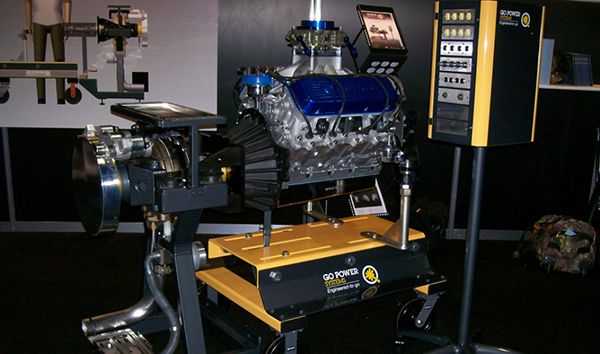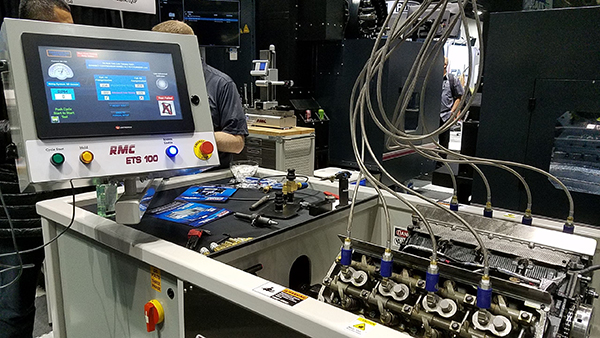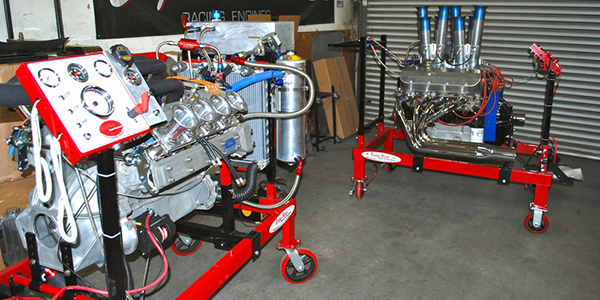Engine dynamometers are great for tuning power and torque, but are they necessary for general quality control testing purposes? Do you need a full engine dyno to bench test an engine? The answer is: it depends. There may be other equipment options that will free up your dyno and provide easy testing and verification for the products you send out the door.
Engine and chassis dynos are primarily intended to measure the power output of an engine or vehicle to aid the tuning process. While many engine builders have a dyno in their shop, many others don’t, so they rent one out at a nearby shop. If you have any problems on the dyno such as a leak or a mechanical issue, you’ll have to pull it off and perhaps bring it back to your shop to fix the problems then bring it back for testing. As they say, time is money, and for engine builders with limited help, there’s not a lot of spare time to waste.

Before you run the engine for the first time on the dyno, why not run it on a test stand or a quality control machine to ensure all the systems are working correctly and there are no problems before the test pull? With a run stand set up in your shop, you can, for example, mount the engine and transmission to test and verify before installation or to make quick component changes and to test them.
Engine Dynos
Engine dyno manufacturers argue that purchasing one of their machines is just as crucial to your business as owning a milling machine, CNC or any other piece of engine building equipment. Engine dynos verify the work you’ve done and puts it on paper with hard data to back up your claims. There’s a wide variety of dyno designs that are rated for very small, low hp engines up to 3,000 hp monsters. But keep in mind that the dyno is only one part of the process to building a dedicated dyno cell. As a tool, the dyno is one of the most productive your shop can own because it will make you money if you use it correctly and keep it busy!
The benefits of owning a dyno are many, but one of the main advantages is for marketing purposes. A dyno can significantly increase value to your engines when you can provide computer printouts of a power curve for the customer’s engine, according to one dyno manufacturer. Adding the term, “dyno tuned” raises the level and quality of your product so you can charge accordingly.
We’ve rounded up some engine testing equipment that will surely make your shop some added profit from either extra services or by keeping the comebacks from rearing up with the following options:

Superflow’s SF-902S engine dyno houses a new absorber designed for high rpm and maximum durability. It’s rated for 15,000 rpm, 1,500 hp and 1,200 lb.-ft. of torque. The PTFE Teflon water seals and high-speed ABEC 7 bearings allow the absorber to run at high rpm for extended testing periods without issue. The new stainless-steel trunnion and backing plate provide a 75% increase in resistance to cavitations compared to previous aluminum bronze components. In addition to the new water seals, high-speed bearings and stainless-steel components the new absorber in the SF-902S dynamometer includes a hall effect speed sensor for greatly improved low-speed rpm measurement. The dyno also includes a roll-around engine docking cart to adapt to various types of engines and its stainless-steel runners mean easy adjustment of the engine supports without any rust.
For more, visit www.superflow.com.
Go Power offers a complete dynamometer system, the GPR557, designed to fill the needs of the high-performance engine builder utilizing the latest in technology including state-of-the-art data acquisition and control combined with a convenient engine cart and reliable D557 absorber. The GPR557 features a “dual drive” philosophy and a unique Linear Control Valve (LCV) technology. The GPR557 produces more accurate tests, offering engine builders/tuners, race teams and individuals lots of flexibility. The system comprises a GPR557 water brake dynamometer (1,500 hp) absorber, GPS-6000 dynamometer data acquisition and control system, engine dynamometer test stand, and engine cart.
For more, visit www.gopowersystems.com.

Quality Control Testing
RMC’s ETS100 engine tester is an accurate and dependable solution to test and identify the most common mechanical issues encountered by engine builders, ensuring your engines will exceed customers’ expectations. The ETS100’s innovative design offers the ability to customize the operator digital control panel with manual and fully automated testing programs, employing the latest electronics, sensors and controls to collect vital data for input to the onboard computer and output to the screen, USB, or email for further analysis or printing.
For more, visit www.rmcengine.com.
Run Stands
Easy-Run Engine Test Stands are portable for ease of engine installation and test run locations, and can open up more time for your dyno cell. The Easy-Run Test Stand provides a simple way to test or break-in camshafts, adjust valves, check for oil and water leaks, perform leak-down tests, fit components, break-in new headers with coatings and heat cycle the engine, as well as many more useful options. It can also be used to run the engine before it is installed in a vehicle. It enables the user to solve problems, make final adjustments and perform any needed repairs before installation. Avoid the frustration of having to remove, repair, and reinstall the engine, possibly multiple times, if problems exist.
For more, visit www.easy-run.net.

Gimme A Break – A Tax Break That Is!
If you are thinking about purchasing new engine test equipment or any other engine building equipment including machine tools, the IRS’s amended Tax Cuts and Jobs Act (TCJA) rules have increased the Section 179 expense deductions to $1 million, and the phase-out limit to $2.5 million.
Section 179 allows businesses to deduct the cost of specific property as an expense when the property is placed in service. For tax years beginning after 2017, the TCJA increased the maximum Section 179 expense deduction from $500,000 to $1 million. The phase-out limit increased from $2 million to $2.5 million. These amounts are indexed for inflation for tax years beginning after 2018.
The Section 179 deduction applies to tangible personal property such as machinery and equipment purchased for use in a trade or business, and if the taxpayer elects, qualified real property. The TCJA amended the definition of qualified real property to mean qualified improvement property and some improvements to nonresidential real property, such as roofs; heating, ventilation and air-conditioning property; fire protection and alarm systems; and security systems. Revenue Procedure 2019-08 explains how taxpayers can elect to treat qualified real property as Section 179 property.
For tax years beginning after 2017, the TCJA also expanded the businesses that must use the alternative depreciation system under Section 168(g) (ADS). A real property trade or business can also elect out of Section 163(j) limit. If it does, the business must use the ADS for nonresidential real property, residential rental property and qualified improvement property. Revenue Procedure 2019-08 explains how electing real property trades or businesses, or farming businesses change to the ADS for property placed in service before 2018 and provides that it is not a change in accounting method.
Businesses can find updates on TCJA implementation on the Tax Reform page of IRS.gov.














